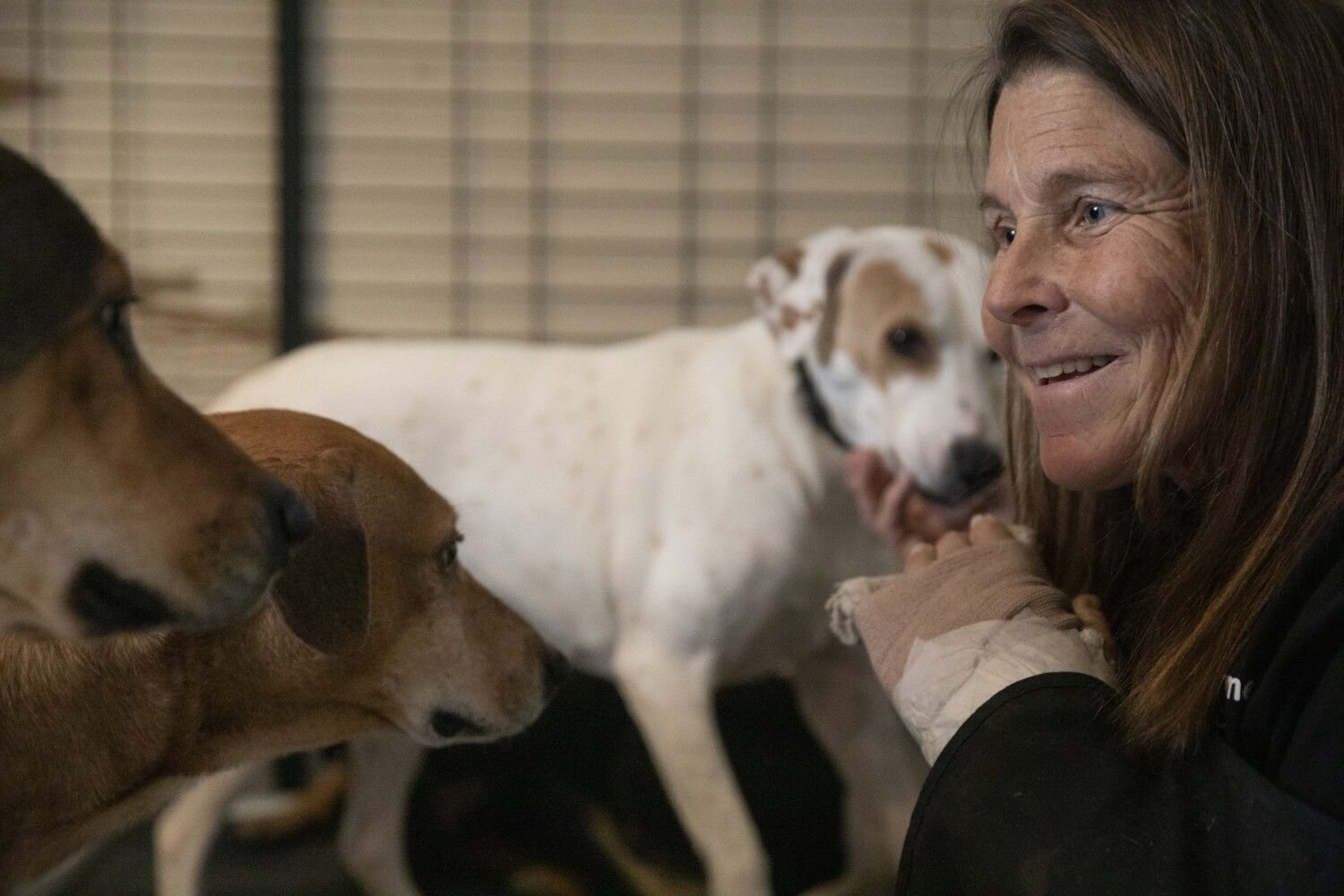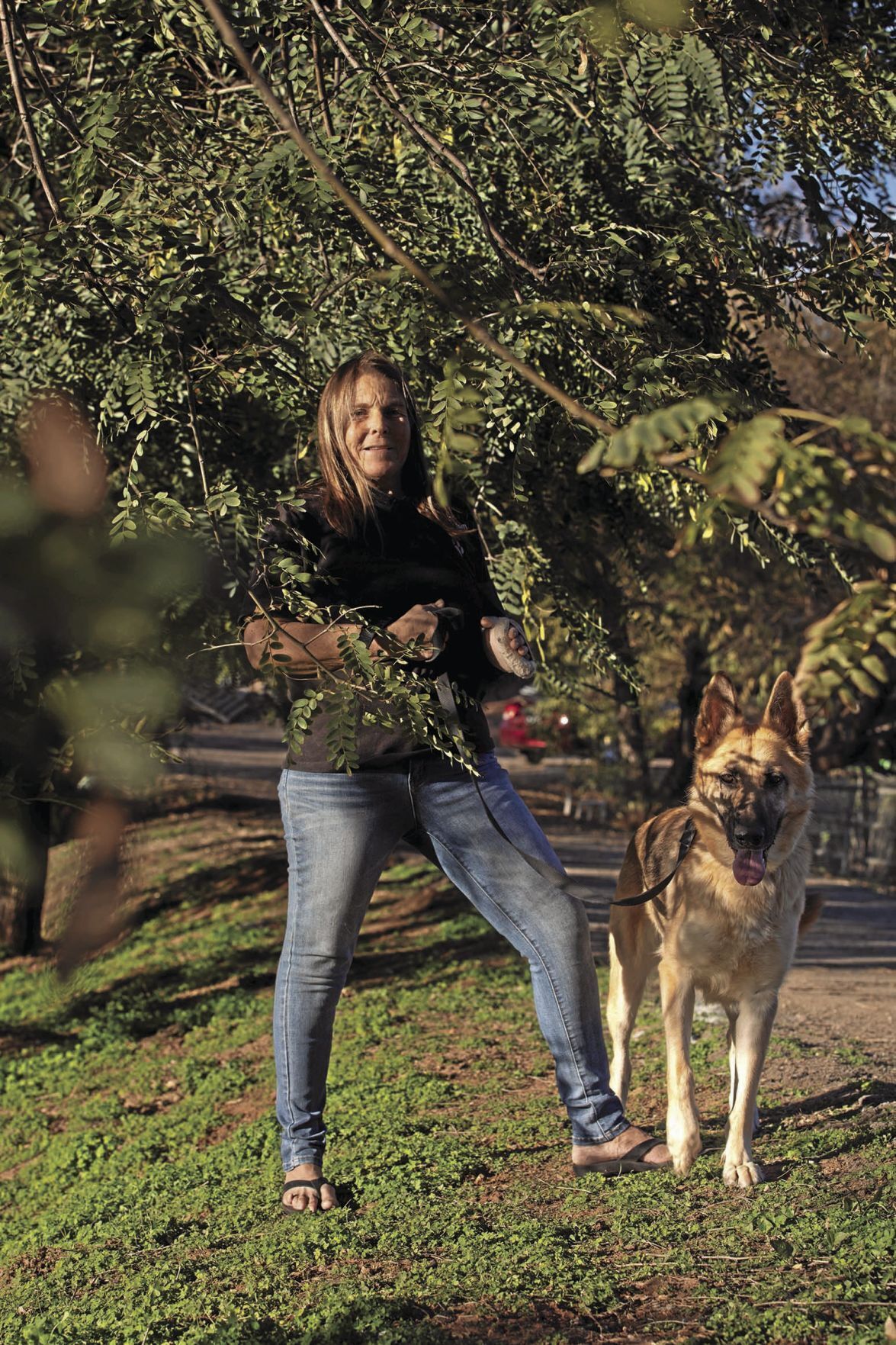Pet tracker’s tips have helped find many runaway dogs

Ana Ramirez, San Diego Union-
Tribune
Babs Fry’s nonprofit, A Way Home for Dogs, has helped reunite hundreds, if not thousands, of families with their lost dogs.
Seven years ago, Babs Fry was devastated when a pregnant terrier mix dog she was fostering disappeared without a trace from her Jamul, California, ranch.
Then she got an email from professional pet tracker Laura Ann Bidinger offering some unusual dog recovery tips that blew Fry’s mind. “Sure enough, 10 days later that dog was in a trap in my driveway,” Fry says.
That was the beginning of a major life shift for Fry, a longtime real estate agent who now dedicates all of her energies to her nonprofit, A Way Home for Dogs. The organization provides free tracking and recovery advice and services to find lost family dogs, as well as strays.
Search and recovery
Since she started training as a tracker and trapper seven years ago, Fry estimates she has helped in the recovery of hundreds, if not thousands, of dogs throughout Southern California and beyond. Her unconventional recovery advice has also been featured on the website of TV’s “Dog Whisperer” Cesar Millan.
Fry jokes that she dedicates “48 hours a day” to dog recovery, fielding up to 50 calls a day from pet owners seeking advice from as far away as Canada, Australia and England. She says she usually juggles about six cases at a time. On her nonprofit’s Facebook page, she posts videos and stories of successful recoveries at least two to three times a week.
Fry generally works alone fielding calls and doing recoveries, but she has a team of about 10 volunteers and the support of her husband, Derek Fry, an executive with a helicopter rental company based in Dallas.
The Frys also own a 22-acre ranch in Texas where someday they hope to open an animal sanctuary. But for now, the focus is entirely on A Way Home for Dogs.
“It’s not a job for her, it’s something she does 24/7. She takes calls in the middle the night,” says volunteer Rita Rodriguez. “She is very committed to helping these animals. Babs has a big, beautiful heart.”
For about 90% of cases, Fry speaks with pet owners by phone to create a tailor-made recovery plan for their dog based on its individual breed, temperament, past behavior and how it got lost.
For the other 10% of cases, Fry goes out in the field herself, often sleeping for days at a time in her truck and using field cameras, rotisserie chickens, clothing bearing familiar scents and humane trapping cages to recover dogs. Most of her recovery missions take three to five days, but some can take a month or more.
That was the case one year ago for a 1-year-old Vizsla named Penny, who escaped from a boarding facility while her owners, Mike and Mandy Colafrancesco, were on vacation. Fry found Penny after 34 days.
The Colafrancescos were amazed by Fry’s tireless efforts on their behalf — and that she refused to accept payment, not even gas money.
So instead, the Colafrancescos repaid her by underwriting the cost and filing the paperwork for making A Way Home for Dogs a nonprofit.
“Our hope is that by having an official nonprofit, she can get donations and have something to build from,” Mike Colafrancesco says.
Fry is grateful for that, because virtually all of her recovery expenses — including gasoline, food, equipment and professional training for stray dogs that have suffered trauma — come from her own pocket. With donations, she’ll be able to track and recover even more dogs.
Happy reunions
When dogs are lost, Fry urges owners not to lose hope. Dogs possess the instinct to survive, even in fierce conditions and without easy access to food and water. Fry says the longer a dog is lost in the wild, the more survival skills it will learn.
“They won’t starve to death. They’ll hunt, they’ll forage and they’ll eat roadkill,” she says. “They’re not biologically engineered to kick the bucket or die of dehydration.”
Colafrancesco says he and his wife were beginning to lose hope of ever seeing Penny again when Fry — who had been posting flyers, following leads and sleeping nights in her truck — picked up video of Penny on a field camera, 28 days after she’d gone missing.
Five days later, Fry was able to lure Penny into a trap cage with a blanket inside bearing the scent of the Colafrancescos’ other dog, Truman. Penny had lost almost half of her body weight, but was otherwise healthy.
“What she does is amazing. Call it a miracle or good fortune, but without Babs’ intervention we would not have our dog today,” Colafrancesco says.
Tips for searching for a lost dog
In order to bring home a lost dog successfully, Babs Fry, director of the nonprofit A Way Home for Dogs, has learned to think like a dog, and the most important piece of advice she can give to distraught pet owners is to battle the urge to go out searching for the dog.
- Pet dogs will naturally try to make their way home by following a scent, but they travel as the crow flies, not by roads or sidewalks, so searching by car doesn’t work. Driving around and looking will also spread the owners’ scent and could confuse a dog.
- Lost dogs are also caught up in a “fight or flight” mindset, so they’re likely to run away from everyone they see, including their owners. Fry says chasing after or shouting at a frightened runaway dog could divert it from its journey home.
- Be sure to contact dog shelters, post flyers and share photos and information on social media.
- The most frequent instances of missing dogs happen around Fourth of July and New Year’s Eve holidays, when fireworks spook many dogs to bolt.

